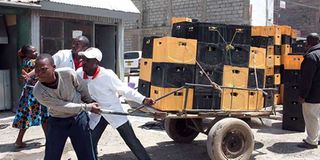Nairobi staggers to the top of booze consumption rank

Creates of beer being ferried from a warehouse in Nairobi. According to a recent survey by Nacada, Nairobi has highest rate of alcohol consumption. FILE PHOTO | NATION MEDIA GROUP
What you need to know:
- Rising number of civil servants with high disposable income push up city’s alcohol consumption rate.
- Nyanza and North Eastern have the lowest consumption rate.
- The Nacada data shows North Eastern and Nyanza have the lowest rate of 2.0 and 10.2 per cent respectively.
Nairobi has highest rate of alcohol consumption, according to a recent survey by the National Campaign Against Drug Abuse (Nacada).
Nyanza and North Eastern have the lowest consumption rate.
Central Kenya also has one of the lowest rates, highlighting the success of the ongoing anti-drinking campaigns.
LOWEST RATE
The Nacada data shows North Eastern and Nyanza have the lowest rate of 2.0 and 10.2 per cent respectively.
Central is third with a prevalence rate of 10. 6 per cent compared to Nairobi, Eastern, Western and Rift Valley, which have 17.5, 14.3, 13.4 and 13.2 per cent respectively.
North Eastern, Nyanza and Central Kenya are below the national average, which stands at 12.2 per cent.
The study that is released every five years targeted Kenyans between 15-65 years in 3,362 households across the eight regions (former provinces in the old constitutional dispensation).
INTENSIFIED FIGHT
The reduction in Central follows an intensified fight, two years after President Uhuru Kenyatta ordered elected leaders and county commissioners from the Mt Kenya region to crack down on the drinking menace.
“There has been an aggressive campaign against alcohol abuse in the last decade compared to other regions. Since the focus has only been in Central, there is a shift to other regions,” said Mr Morris Kamenderi, the principal research officer at Nacada.
The shift is further highlighted by an increase in licensed bars led by Eastern and Nairobi.
According to the report, 70 per cent of respondents in Eastern expressed concern over the rise of licensed bars in their region, followed by Nairobi and Coast at 57. 3 and 52.5 per cent respectively.
LICENSED BARS
In Central, 46.5 per cent of respondents expressed concern over the increasing number of licensed bars.
In March, Interior Principal Secretary Karanja Kibicho blamed counties for the rise in licensed bars as they seek to increase their revenue streams. “Poverty among low-income earners in the capital and an increase in disposable income led to an upsurge in alcohol abuse in Nairobi,” says Nacada.
The reasons behind the increased alcohol abuse in Nairobi include the high population of government employees, who have a higher disposable incomes, and the largest population of in-formal settlements in Kenya, according to the study.
Mr Kamenderi further says improving returns from sale of miraa (khat) has contributed to higher disposable incomes in Eastern region, leading to the rise in alcohol consumption.
RELATED DISORDERS
The alcohol tragedy bedevilling the nation is evident in its staggering rate of related disorders.
At least 2.8 million Kenyans are battling alcohol-related disorders or a prevalence rate of 10.4 per cent, double the number affected by tobacco and miraa at 1.8 million and 0.8 million respectively.
An even bigger concern is the high number of people suffering from alcohol disorders in the productive age, mainly university graduates and workers at the peak of their careers in the 25-35 age bracket.
They make up 12. 8 per cent of those affected, threatening the nation’s endeavour to realise the Vision 2030 development goals by depriving it of the much-needed workforce.
ALCOHOL DEATHS
According to the Interior Ministry, the country is losing at least 5,000 people to alcoholism every year.
Coincidentally, Nairobi has the highest cases of alcohol-related disorders at a rate of 18.4 per cent followed by Western at 13.1 per cent, while Eastern stands at 10.6 per cent.
Central has the second lowest rate at 8.3 per cent after North Eastern with 1.4 per cent.
Alcohol consumption in rural Kenya has been on the rise with a prevalence rate of 29.6 per cent compared to 31.7 per cent in urban areas.
DEVOLUTION
The increase coincides with the establishment of devolved governments in 2013, which created more jobs across the counties, leading to an increase in disposable incomes.
In March, the government announced a four-month crackdown on illicit brews in 25 regions, exempting North Eastern, which is the least affected by alcohol consumption.
The government has in recent months intensified its war against alcoholism, marked by high profile swoops on illicit drinks across the country. Illegal alcohol worth at least Sh315 million has so far been impounded in Nairobi and Kisumu.





